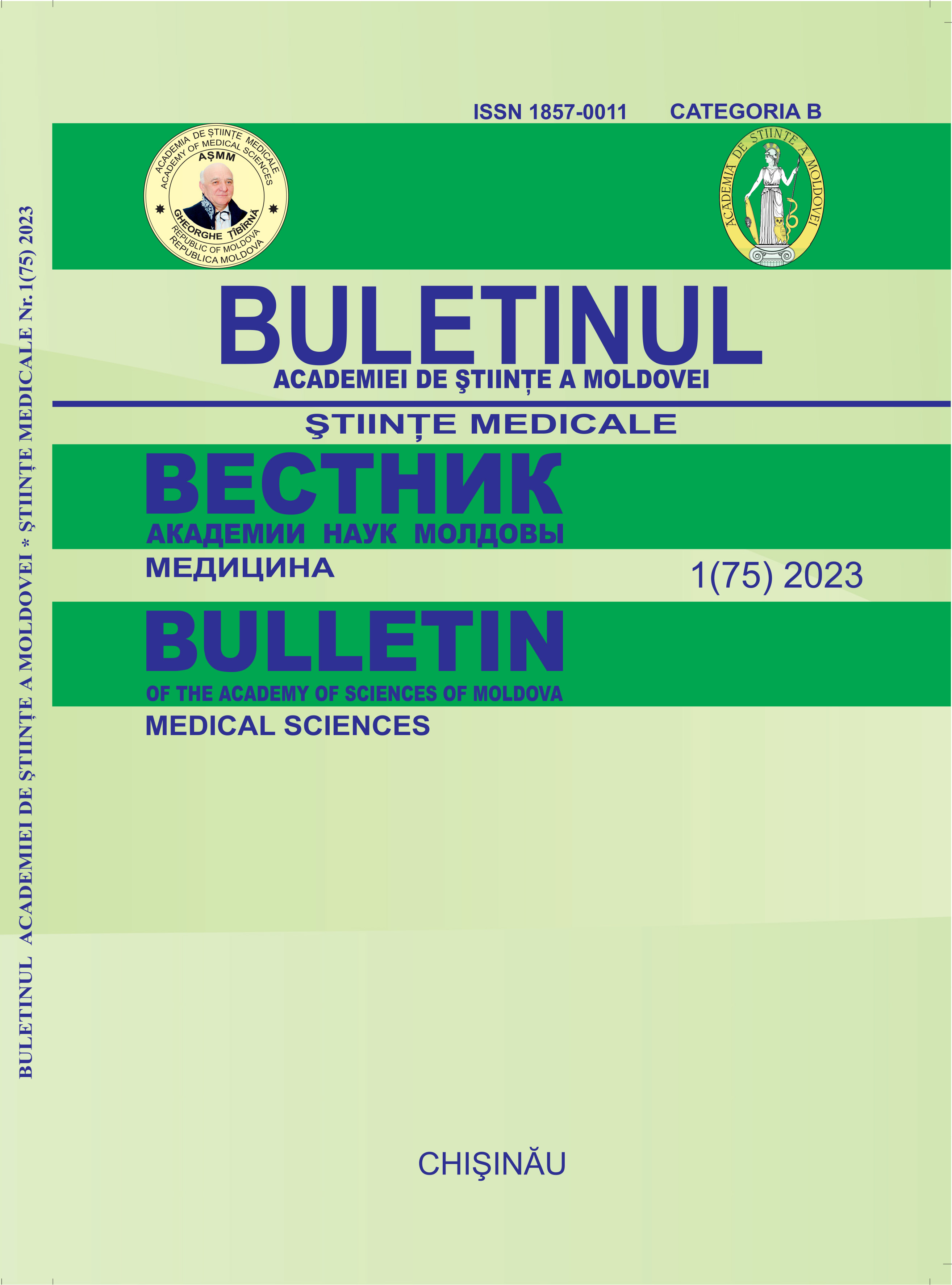Optimal reperfusion time in patients with non-ST elevation acute myocardial infarction and low ischemic risk
DOI:
https://doi.org/10.52692/1857-0011.2023.1-75.03Keywords:
acute myocardial infarction with non-ST elevation, echocardiography, reperfusion time, delayed reper- fusion, low ischemic riskAbstract
The aim of the study was to identify the optimal time window for performing effective percutaneous coronary reperfusion in patients with non-ST-segment elevation acute myocardial infarction (NSTEMI) who are part of the low ischemic risk group. 252 patients with NSTEMI and low ischemic risk who underwent coronary angioplasty up to 30 days after the onset of the infarction were evaluated the second day post-procedurally and at a distance of 6 months. The general group was randomized depending on the echocardiographic evolution. 131 patients with unfavorable evolution and 121 with more complete restoration of left ventricular contractile function. The time windows from the onset of myocardial infarction symptoms in which percutaneous myocardial reperfusion was applied were studied. Following the study, the time interval of 73 hours -14 days proved to be optimal in which a more favorable clinical and echocardiographic evolution is ensured.
References
Cardiovascular diseases [Internet]. [citat 12 mai 2020]. Disponibil la: https://www.who.int/westernpacific/health-topics/cardiovascular-diseases
Timmis A, Townsend N, Gale C, Grobbee R, Maniadakis N, Flather M, et al. European Society of Cardiology: Cardiovascular Disease Statistics 2017. Eur Heart J. 2017;39(7):508–79.
Zhang Q, Zhao D, Xie W, Xie X, Guo M, Wang M, et al. Recent Trends in Hospitalization for Acute Myocardial Infarction in Beijing: Increasing Overall Burden and a Transition From ST-Segment Elevation to NonST-Segment Elevation Myocardial Infarction in a Population-Based Study. Medicine (Baltimore). februarie 2016;95(5): e2677.
O’Donoghue M, Boden WE, Braunwald E, Cannon CP, Clayton TC, de Winter RJ, et al. Early Invasive vs Conservative Treatment Strategies in Women and Men With Unstable Angina and Non–ST-Segment Elevation Myocardial Infarction: A Meta-analysis. JAMA. 2008;300(1):71–80.
Fox KAA, Clayton TC, Damman P, Pocock SJ, de Winter RJ, Tijssen JGP, et al. Long-Term Outcome of a Routine Versus Selective Invasive Strategy in Patients With Non-ST-Segment Elevation Acute Coronary Syndrome A Meta-Analysis of Individual Patient Data. J Am Coll Cardiol. 2010;55(22):2435–45.
Henderson RA, Jarvis C, Clayton T, Pocock SJ, Fox KAA. 10-Year Mortality Outcome of a Routine Invasive Strategy Versus a Selective Invasive Strategy in Non– ST-Segment Elevation Acute Coronary Syndrome. J Am Coll Cardiol. 2015;66(5):511.
Noc M, Fajadet J, Lassen JF, Kala P, MacCarthy P, Olivecrona GK, et al. Invasive coronary treatment strategies for out-of-hospital cardiac arrest: a consensus statement from the European association for percutaneous cardiovascular interventions (EAPCI)/stent for life (SFL) groups. EuroIntervention J Eur Collab Work Group Interv Cardiol Eur Soc Cardiol. mai 2014;10(1):31–7.
Katritsis DG, Siontis GCM, Kastrati A, van’t Hof AWJ, Neumann F-J, Siontis KCM, et al. Optimal timing of coronary angiography and potential intervention in non-ST-elevation acute coronary syndromes. Eur Heart J. 2011;32(1):32–40.
Navarese EP, Gurbel PA, Andreotti F, Tantry U, Jeong Y-H, Kozinski M, et al. Optimal timing of coronary invasive strategy in non-ST-segment elevation acute coronary syndromes: a systematic review and meta-analysis. Ann Intern Med. 2013;158(4):261.
Collet J-P, Thiele H, Barbato E, Barthélémy O, Bauersachs J, Bhatt DL, et al. 2020 ESC Guidelines for the management of acute coronary syndromes in patients presenting without persistent STsegment elevation: The Task Force for the management of acute coronary syndromes in patients presenting without persistent ST-segment elevation of the European Society of Cardiology (ESC). Eur Heart J [Internet]. 2020 [citat 26 septembrie 2020];(ehaa575). Disponibil la: https://doi.org/10.1093/eurheartj/ehaa575
Surev A. Particularitățile tratamentului intervențional al infarctului miocardic acut fără supradenivelarea segmentului ST: Teză de doctor în științe medicale:321.03 – Cardiologie [Internet] [Thesis]. 2022 [citat 2 februarie 2023]. Disponibil la: http://repository.usmf.md/./handle/20.500.12710/19554.
Downloads
Published
License
Copyright (c) 2023 Bulletin of the Academy of Sciences of Moldova. Medical Sciences

This work is licensed under a Creative Commons Attribution 4.0 International License.



